AWS Cost Explorer
Overview
While keeping a track of your costs can be hectic, AWS offers AWS Cost Explorer which helps to solve this problem with a daily or monthly granularity. AWS Cost Explorer is an easy-to-use AWS service with an interactive interface that helps to visualize, acknowledge, understand, and manage the AWS costs incurred and data usage over time. AWS Cost Explorer helps in creating customized reports for analyzing the data usage and costs incurred in addition to usage forecast for a future time range for the report.
Introduction to AWS Cost Explorer
Once we start working with AWS services we get charged after a certain threshold is exceeded. Now how do we keep track of the costs that we shall be incurring? Also, forecasting based on the pattern of usage, how much should the budget go next month? Also, is there any AWS service that lets us filter and group to figure out where the AWS money is going?
To answer all these questions, AWS came up with AWS Cost Explorer which is an easy-to-use AWS service with an interactive interface that helps to visualize, acknowledge, understand, and manage the AWS costs incurred and data usage over time. AWS Cost Explorer helps in creating customized reports for analyzing the data usage and costs incurred in addition to usage forecast for a future time range for the report.
With its rule-based models, we get optimization recommendations, and customized cost anomaly notifications in addition to providing an interface that helps to visualize, understand and manage your AWS costs and usage over time. All of this helps the users of the AWS account from any surprise billing as shown below.
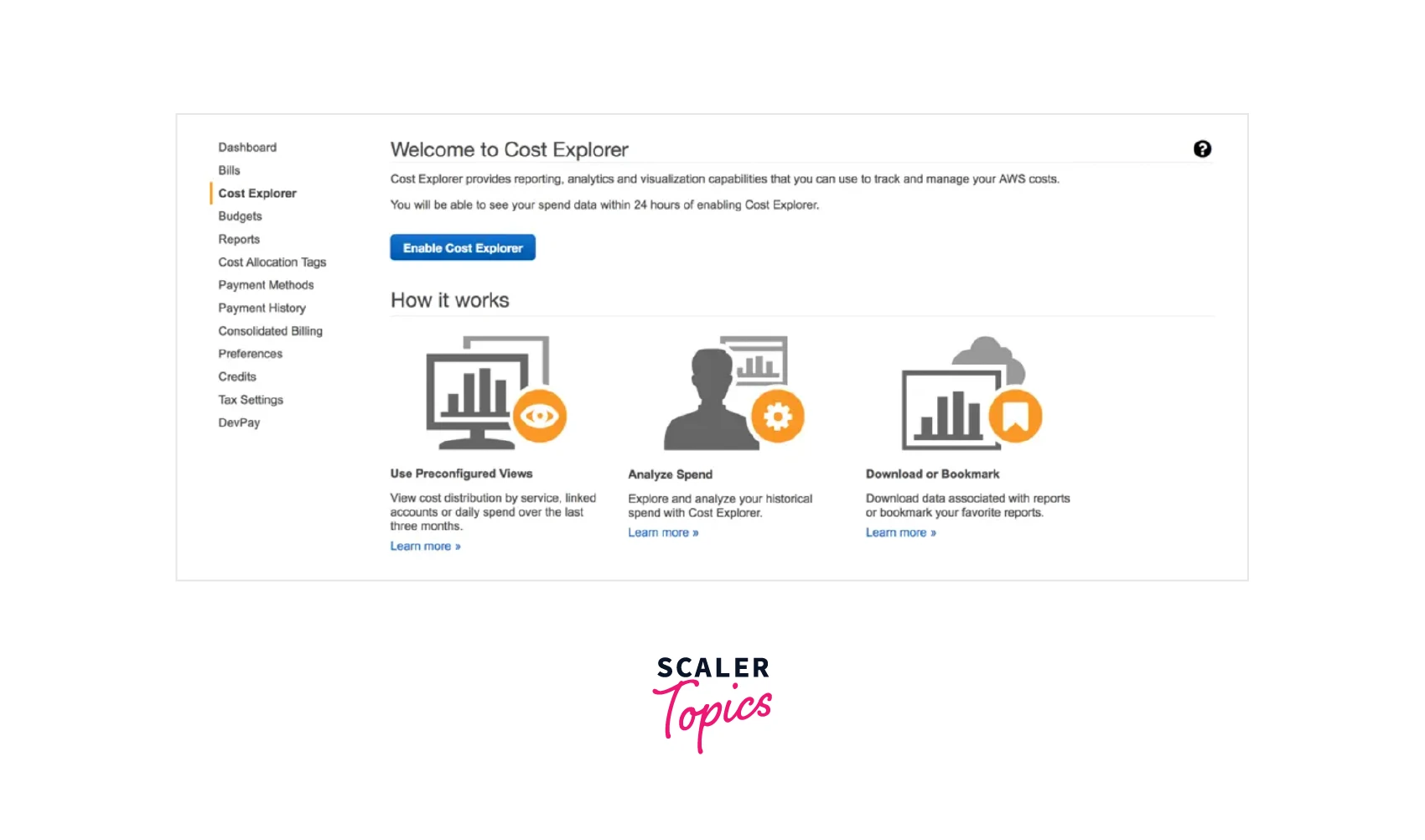
AWS Cost explorer starts its analysis by tracking the higher spending first, along with grouping your costs to deal with any misspelled tags. Here tags are referred to as labels that you use for organizing the AWS resources, where these cost allocation tags help to monitor and track the AWS costs in a detailed manner. This helps to keep a check on the misspelled tags also. With the hourly data available we are shown resource IDs tag policies which can help to import tags across multiple attribute accounts. All these help to review charges and usage costs associated with individual accounts or any AWS Organisation's spending and get recommendations for what reserved instances to purchase.
The key factors for AWS Cost Explorer are:
- We get complete information on costs incurred and data usage information in addition to preconfigured views for the business insights.
- With the filtering and grouping provided by AWS Cost Explore we can understand in detail the cost incur and data usage.
- We can forecast costs that will be incurred for the upcoming twelve months along with data usage for a future period based on the AWS Cost Explorer analysis report along with receiving recommendations on which reserved instances to purchase.
- Creation, saving, and distribution of customized reports for the exploration of various sets of data.
- Track your total cost incurred and data usage across all accounts, for monthly, hourly, or resource level.
How Does It Work?
The below diagram shows how the AWS Cost Explorer works to provide visualization, acknowledge, understand, and manage the AWS costs incurred and data usage over time.
The working of AWS Cost explore is by first digging into the data and filtering and grouping the functionality that is like together. Then it views the data at detailed levels which is used to further forecast costs.
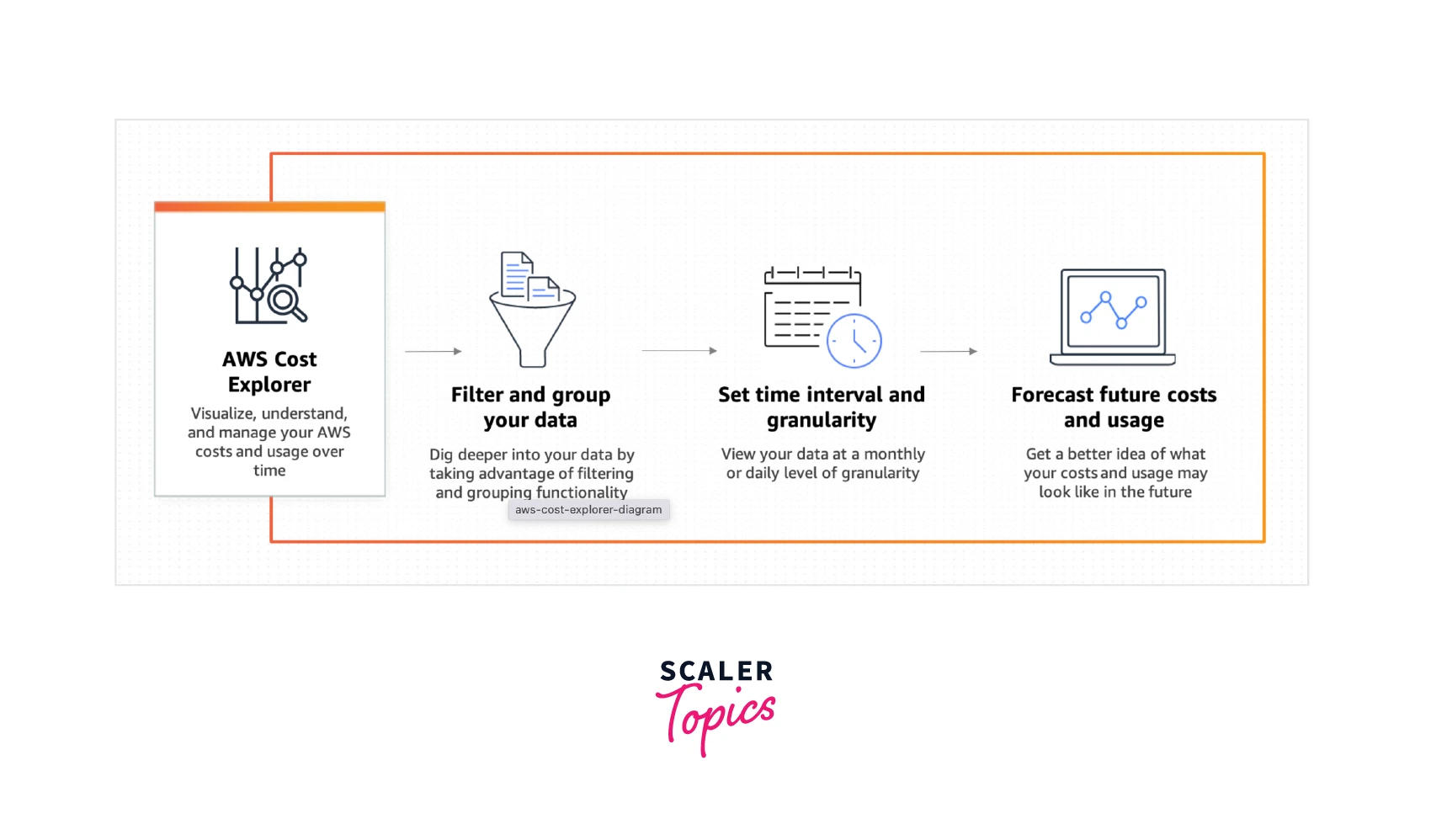
With a user-friendly interface, AWS Cost Explorer is really easy and quick to get work with, and creating customized reports that help the users analyze the costs incurred and data usage over time. The analysis of the data at a high level can be done by tracking and analyzing the total costs and data usage across all AWS accounts or digging deeper to understand and analyze the cost incurred and data usage for identifying the trends, pinpointing cost drivers, and detecting the anomalies if any.
We can enable the AWS Cost Explorer for the AWS account using the above-shown steps(in the diagram) from the AWS Billing and Cost Management console. It is not possible to enable the AWS Cost Explorer via the API. Once enabled, AWS starts to immediately track all the data and prepares reports about the costs incurred for the current month in addition to the last 12 months, after which it calculates and analyzes. It then makes predictions and forecasts costs that the user might incur in the next 12 months. Users can view the current month's data for about 24 hours while the remaining viewing of data takes time for about a few more days. Also, the AWS Cost Explorer updates at least once every 24 hours for your cost data.
AWS Cost Explorer Features
Listed below are a few features that AWS. Cost Explorer offers to its users:
Monthly Cost Incurred by AWS Service With default report that we create with AWS Cost Explorer helps the users to visualize the costs incurred and data usage linked with the top five cost-accruing AWS services along with a detailed breakdown in the tabular view. With these reports, we can time range and view historical data from the past twelve months to understand the cost trends.
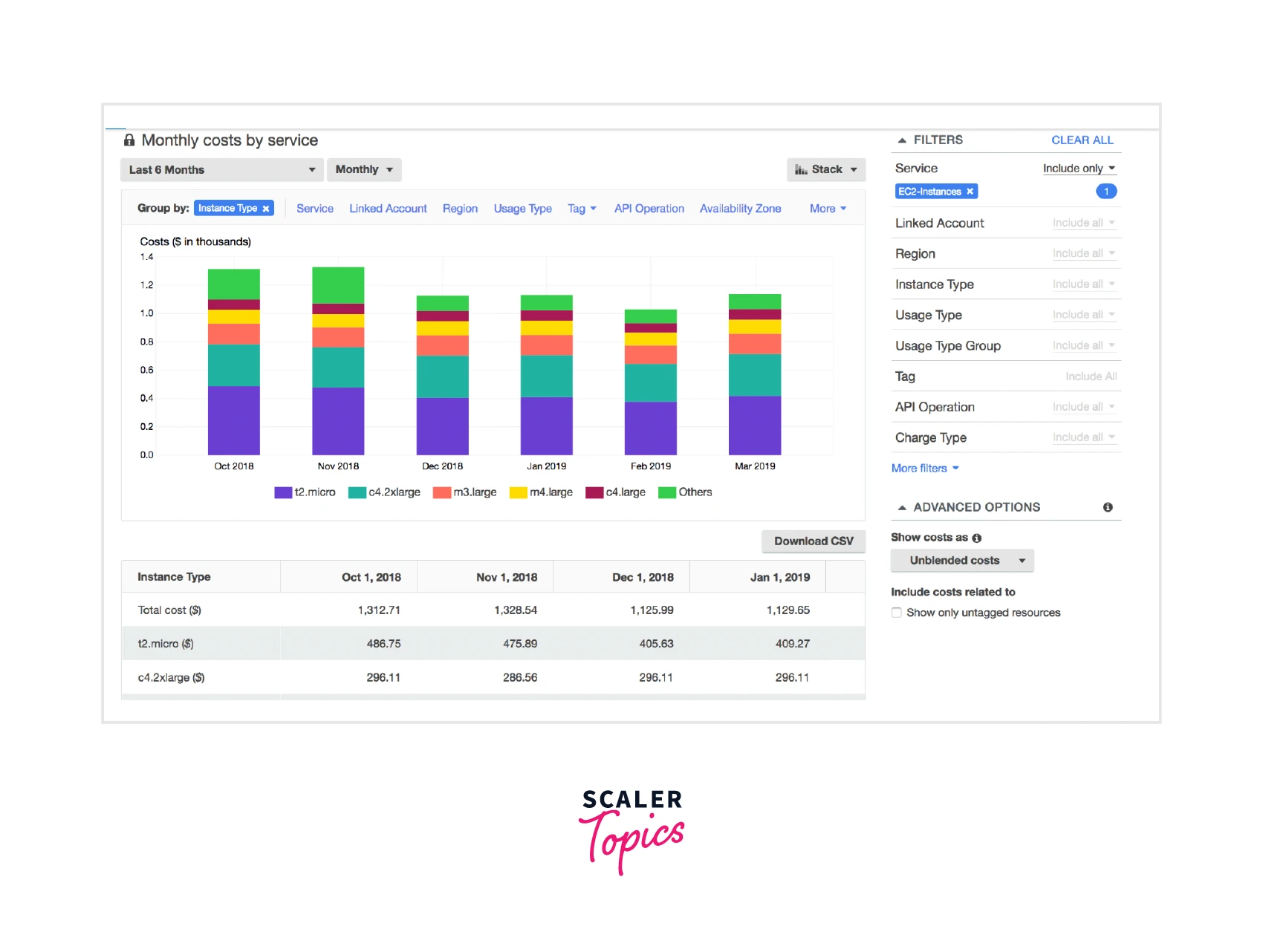
Monthly cost incurred by Linked Account With the AWS Cost Explore interface, we can view the monthly cost incurred, group them by Linked Accounts, and filter the cost incurred data for each member AWS Account in the AWS organization. We can also configure generating reports in AWS Cost Explorer and save the data reports as a .csv file too as shown below.
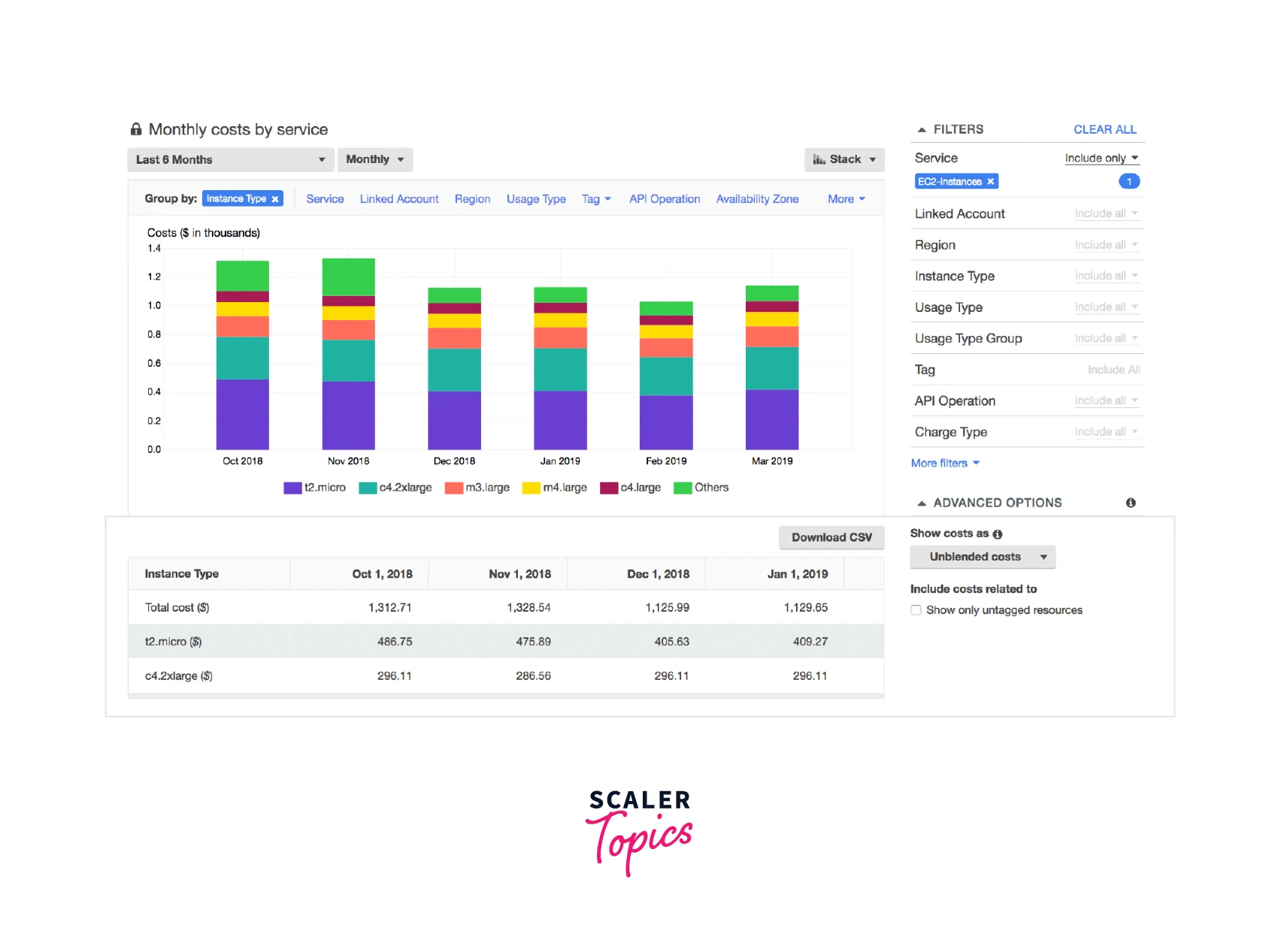
Reservation reports With AWS Cost Explorer we get access to two reports namely - The reservation utilization report and the Reservation coverage report which help analyze the RI purchases and cost-saving opportunities as shown below. With the reservation utilization report, we can set a customized reservation utilization target and visualizes the aggregate reservation utilization as well as understand how our resources doing. Whereas with reservation coverage reports, we can get an overall visualization for the reservation coverage where we can still set customized reservation coverage targets which can help identify opportunities for savings purposes.
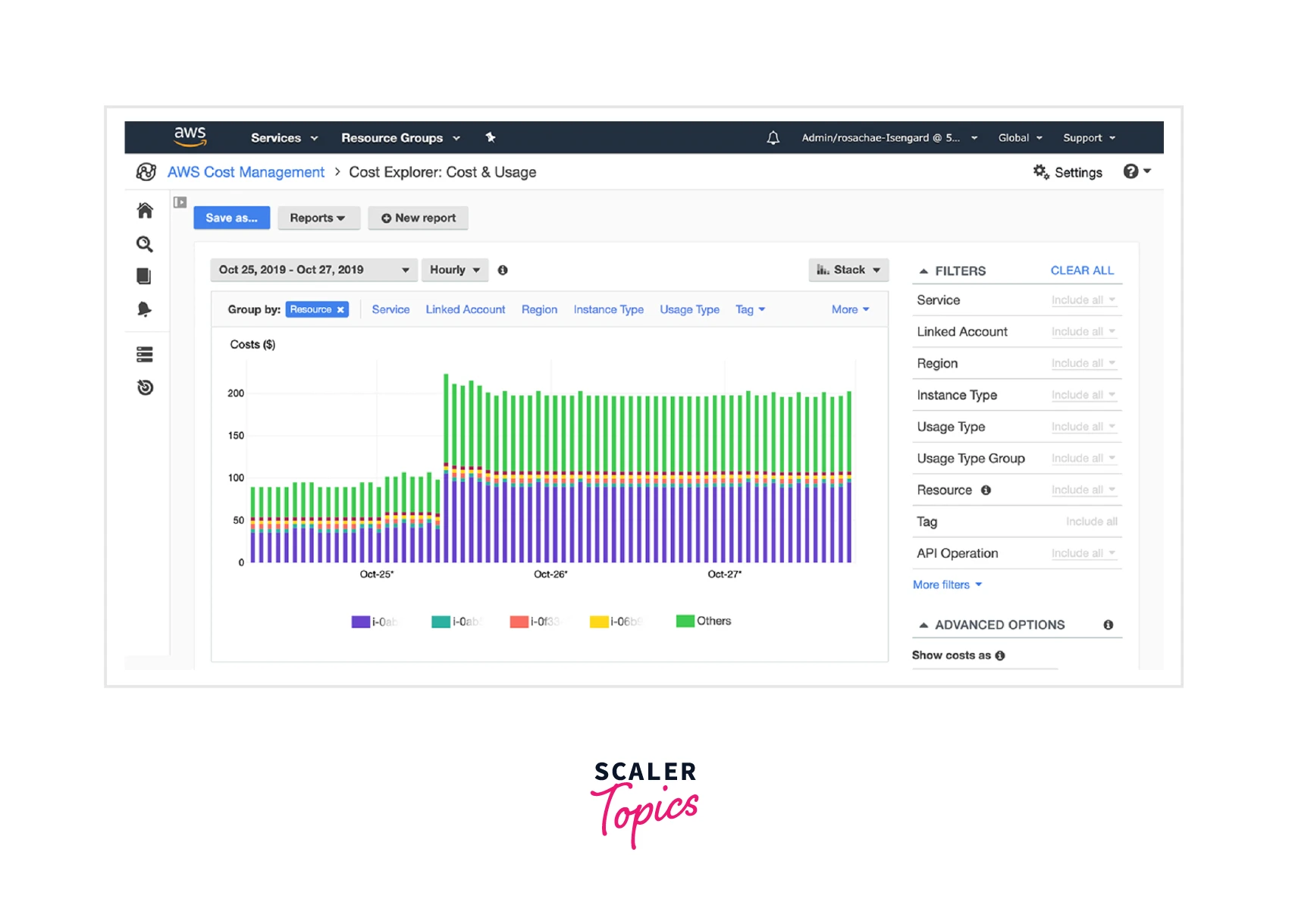
Savings Plans reports With AWS Cost Explorer we get two types of Savings Plans reports namely Savings Plans utilization report and Savings Plans coverage report that helps to analyze purchases and capture saving opportunities as shown below.
The Savings Plans utilization report helps to visualize the aggregated Savings Plans utilization where we can set customized Savings Plans utilization targets which can help understand how well we use the AWS resources. Whereas with the Savings Plans coverage report, we can visualize the complete Savings Plans and can set customized Savings Plans coverage target that helps to identify opportunities for savings.
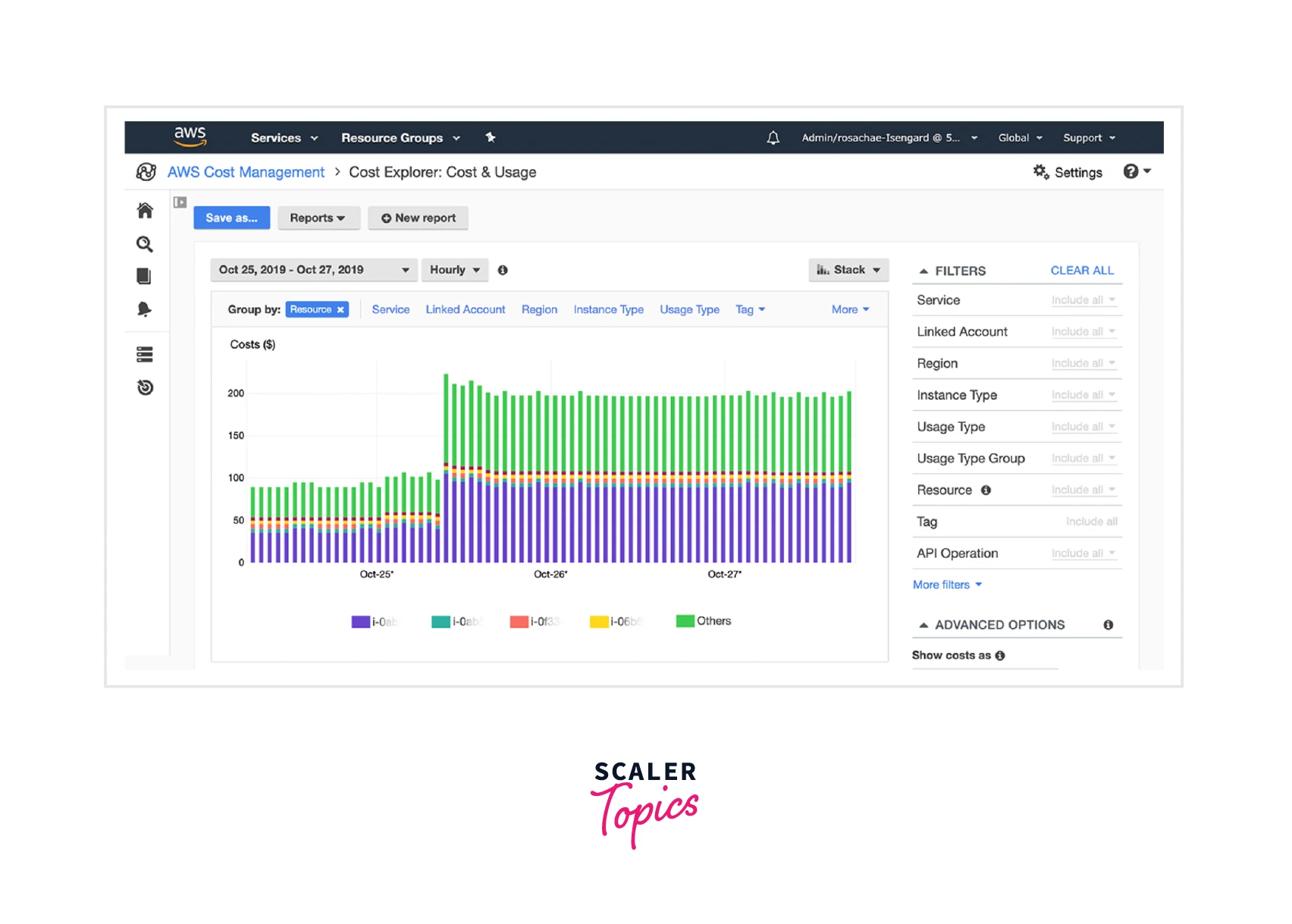
Hourly and Resource Level Detailed Granularity We can visualize, acknowledge, understand, and manage the AWS cost incurred and data usage for daily or monthly level granularity. We can also dig deeper through detailed filtering and grouping dimensions like Usage Type and Tags with additional functionality to access the data by enabling hourly and resource-level detailed granularity as shown below.
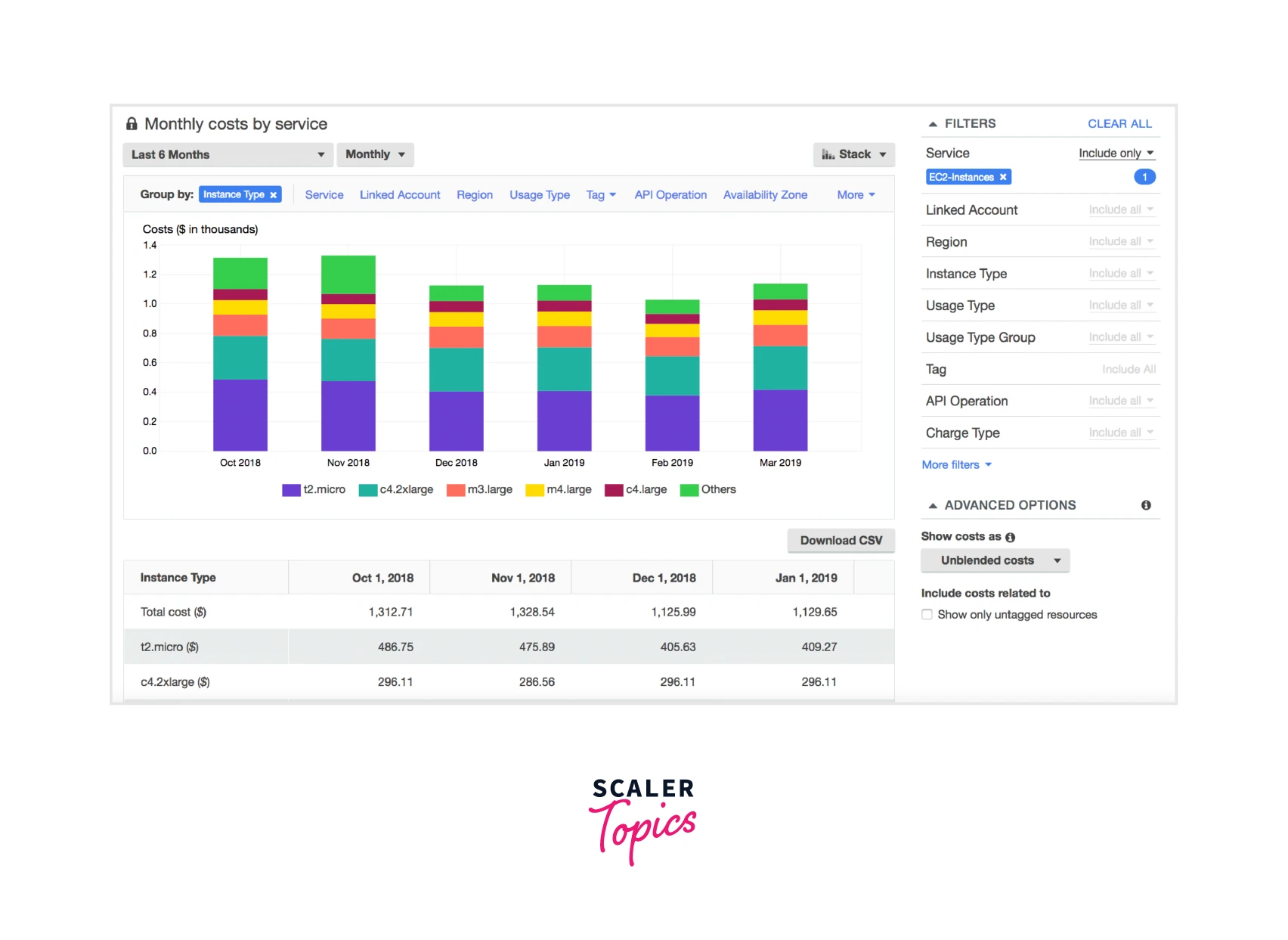
AWS Cost Explorer Use Cases
A few widely known use cases of implementing the AWS Cost Exlere are listed below that can help us understand the functionality offered by Cost Explorer and help in future scenarios:
Developing customized applications By implementing the AWS Cost Explorer, we get direct access to the interactive and ad-hoc analytics engine which gives the AWS Cost Explorer its capability. With the Cost Explorer API, we can programmatically query for costs and usage data.
Start Forecasting by implementing AWS Cost Explorer To estimate future AWS bills and set alarms or notifications if budgets are getting exceeded based on the predictions, by simply implementing the AWS Cost explorer and forecasting the costs. The report can be generated for future time ranges which are highly convenient for managing costs.
Using granular and detailed filter You can visualize, acknowledge, and manage your AWS costs and usage with AWS Cost Explorer for granularity at daily or monthly levels too. AWS Cost explorer offers hourly and resource-level granularity too for further detailed estimations if required as shown below.
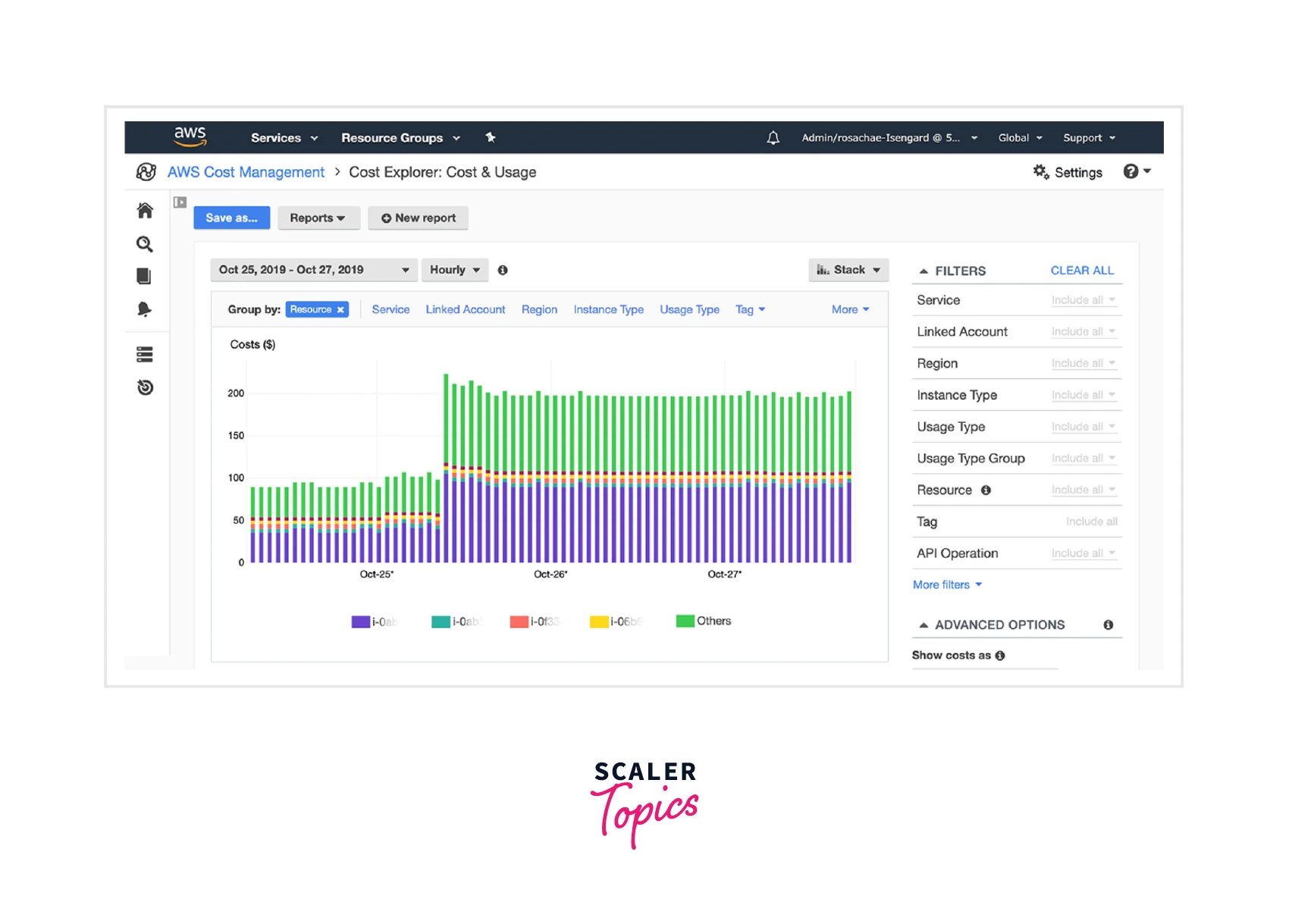
Enabling and Getting Started with AWS Cost Explorer
Now we shall understand how can how we can easily enable and quickly get started with AWS Cost Explorer as we move along this section.
AWS Cost Explorer is Simple to Get Started - With the ability to understand a detailed view of the cost incurred and data usage data for tracking trends, isolating the cost drivers, and detecting any suspicious anomalies, AWS Cost Explorer is easily enabled from the AWS Management Console. The enabling can happen either via a dedicated service link which can be found under the AWS Cost Management service category or via simply searching. We can also access it from the AWS Billing Console but remember that you can't use the API to enable the AWS Cost Explorer.
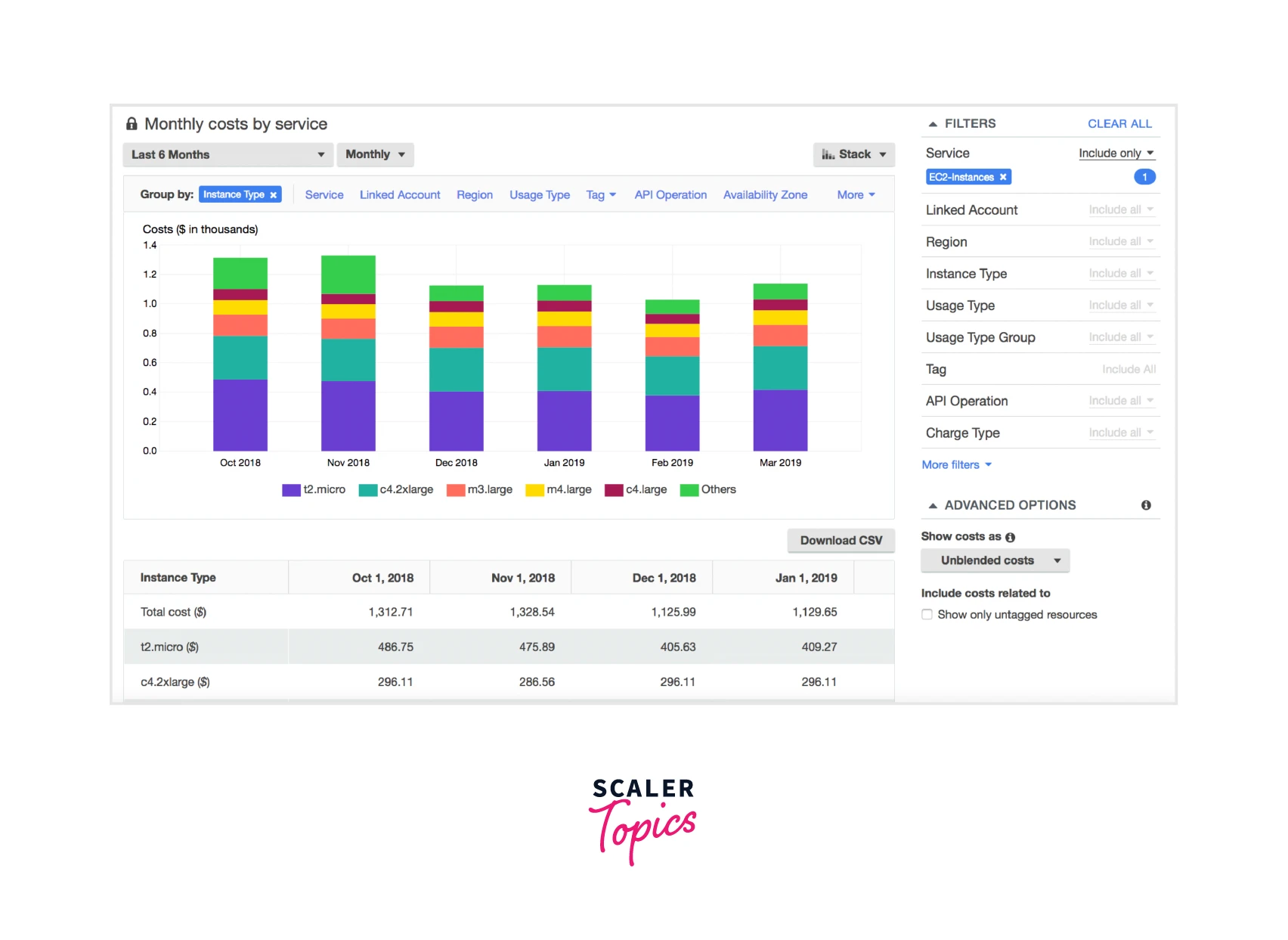
AWS receives a signal when you access the AWS Cost Explorer that the user of the AWS account wants to let the system auto-fill the cost and usage data. This process might take up to 24 hours to be available for the month-to-date cost and usage information or can even go up a max of 72 hours to prepare the past 12 months of historical data from your account costs data.
Quickly Getting Started with AWS Cost Explorer -
- Go to the AWS Billing console through the link -here.
- On the navigation pane select AWS Cost Explorer which shall direct you t the Welcome to AWS Cost Explorer page.
- Once enabled, AWS immediately starts looking for the higher spends and details related to costs incurred for the last 12 months along with tracking the current month and eventually forecasting for the coming 12 months.
- Current month’s data is visible in approximately 24 hours, and updates for the cost data are given at least every 24 hours.
- The predicted costs, monthly trends, and month-to-date spend can be seen from the AWS Cost Explorer interface the cost summary is also visible. This helps the users track its cost and usage movements and if it's keeping with the forecasted data or not.
- With the Monthly Trends section, users can track and monitor any suspicious anomalous usage.
- As shown below select AWS Cost Explorer >>> Costs and Usage for analyzing the costs and used independently.
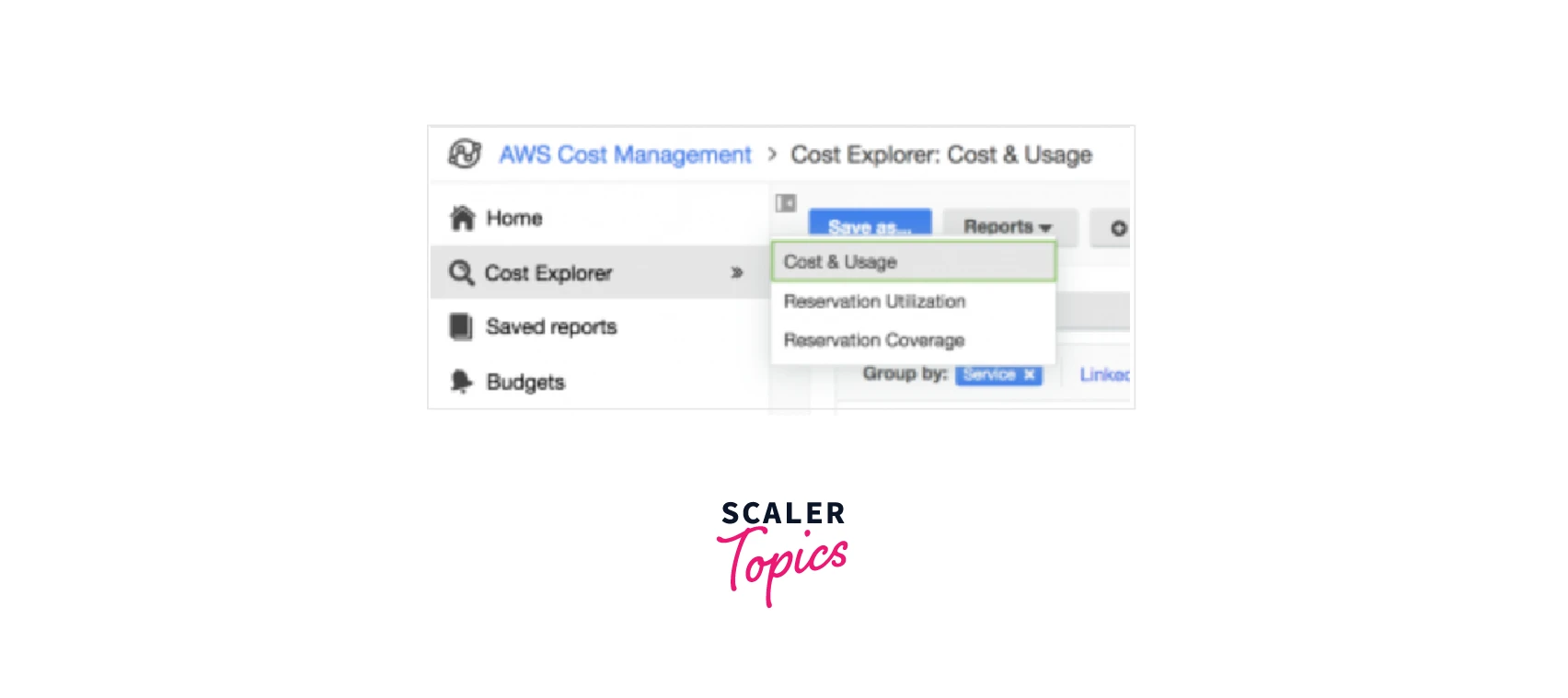
- There We can view monthly costs arranged by AWS service as Aws Cost Explorer his pricing data exploration surface. This will help to track the last six months of AWS usage and provide specifics on a monthly level.
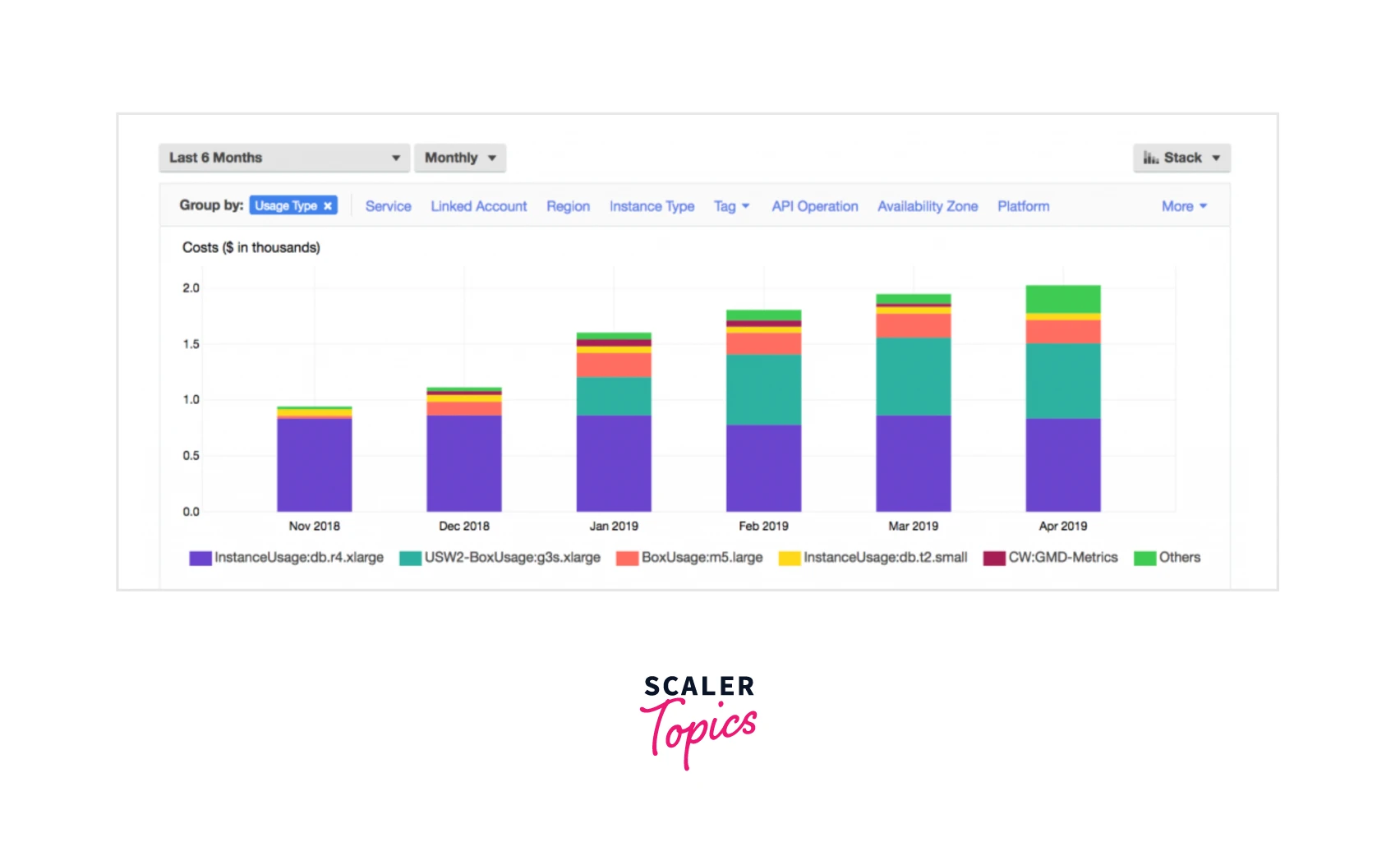
How Does AWS Cost Explorer Help Reduce the Cloud Costs?
Now we shall learn how we can optimize the use of AWS Cost Explorer Help to reduce the cloud costs incurred. We shall be diving deep into two sub-topics:
- Exploring Your Data Using Cost Explorer
- Understanding Your Reservations with Cost Explorer
When we start with AWS Cost Explorer, we get a walkthrough of all the main parts of the AWS console in addition to an elaborate explanation for each section where the preconfigured views display details about the cost trends which helps us to customize spending plans according to our needs.
Exploring Your Data Using Cost Explorer
Well, to explore the data via the AWS Cost Explorer we shall navigate to the AWS Cost Explorer dashboard to verify the approximate costs incurred to date for the month along with a graph that helps track the daily costs incurred, the forecasted costs for the month, the major five cost trends, in addition to a record containing recently viewed reports as shown below.
AWS Cost Explorer graphs:
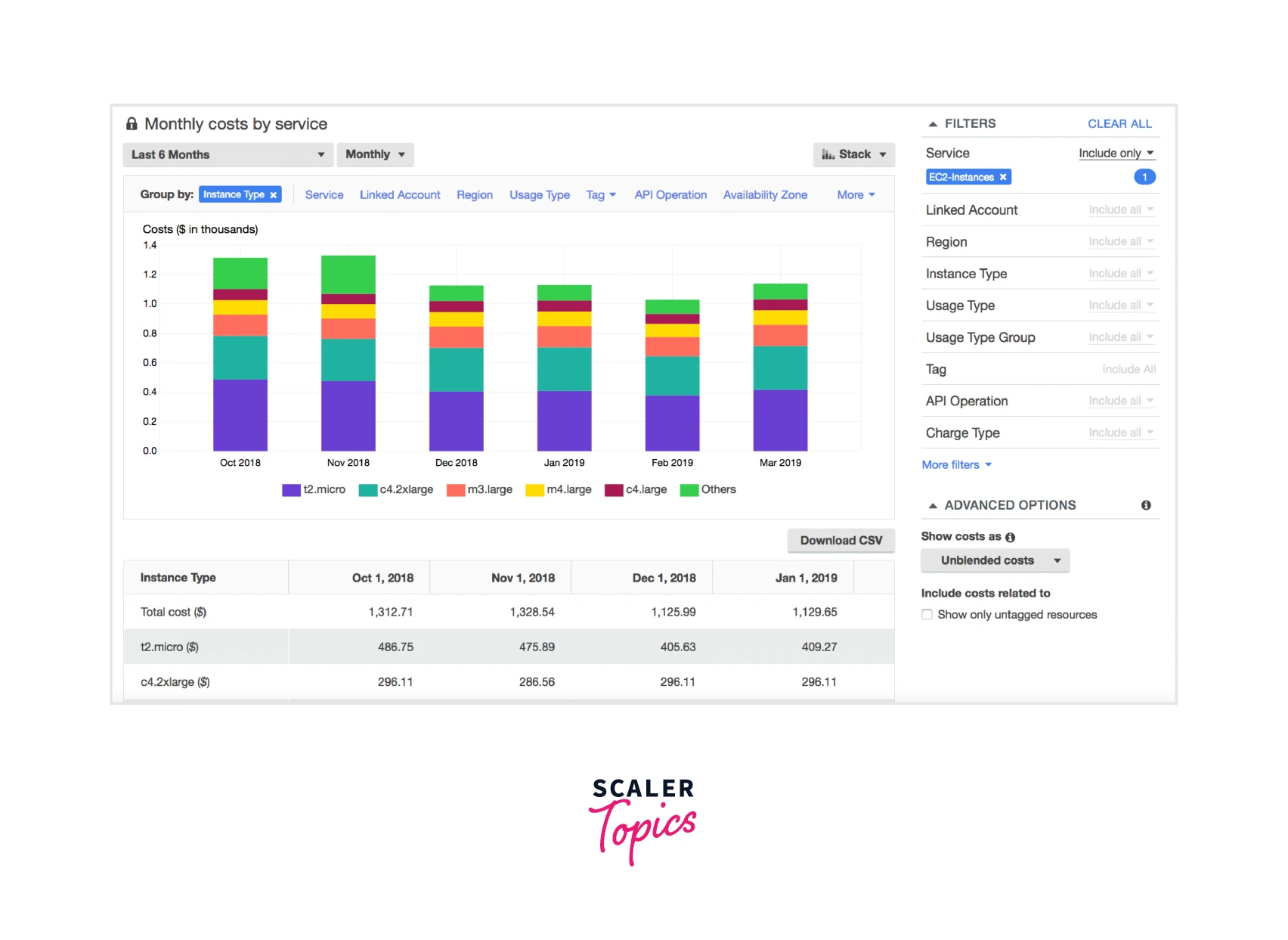
The three major monthly costs details we get from the AWS Cost Explorer costs are:
- Month-to-date costs : Here we make the comparison between the forecast costs to date for monthly spending with actual costs incurred. We can also compare the costs incurred for the same period of the last month.
- Predictions of month-end costs : Here an estimate is given out for the costs incurred at the end of the month which can also be compared with the prediction with real costs from the last month to check on the accuracy of the predictions.
- QuickNote: NO refunds are calculated for Forecasted month-end costs. Neither for the month-to-date nor the forecasted month-end costs.
- Unblended monthly and daily costs : Cost Explorer provides a graph of the up-to-date unblended daily expenditures. Select Explore costs to modify parameters and filters for the chart.
Next, let us learn about the Cost Explorer trends:
From the AWS Cost Explorer trends, we get to estimate and track the major cost trends in the “This month trends” section. You need to click the View all trends option to see the overall cost trends.
Here you can select a trend to get an in-depth report where the AWS Cost Explorer chart can be seen. These charts show the costs that were used for calculating the trend which helps the users understand if the costs linked with a specific AWS service have grown or if suspicious charges are getting charged or not.
Lastly, we have the Amortized Reserved Instance (RI) costs for Exploring Your Data Using Cost Explorer
With the Amortized RI costs, we get the overall view of the costs incurred against the Reserved Instance (RI) purchased for the data usage against the reservation. The unblended recurring and upfront reservation costs are calculated by AWS which determines the adequate rate of application instances. With the daily report, AWS Cost Explorer highlights the unused and unexplored parts of the reservation costs calculated from the purchase date or the start of the month.
Understanding Your Reservations with Cost Explorer
With AWS Cost Explorer offering such diverse detailing concerning costs that a user incurs throughout its entire usage with AWS Account, let us understand with this section how we can leverage the Reservations made with AWS Cost Explorer.
AWS always focuses on balancing the data usage for the Reserved and On-Demand Instances. Hence, we get the capability offered by AWS Cost Explorer where we get tools providing insight into the largest RI costs.
The insights can be leveraged to cut down your costs by:
- Granting rundown for the up-to-date reservations
- Highlighting the RI coverage and its utilization
- Providing recommended RIs that minimize the expenses once you buy them.
Question can be How to leverage the benefits from the RI reports
It's easy!
In the console, open the RI reports and search for
- The number of reservations that you occupy,
- The number of reservations that shall expire in the month
- the amount that can be saved from your reservations as compared to estimated On-Demand Instances.
With AWS Cost Explorer, you get highlighted for how the instances are getting utilized, the cost savings, and reservations made for service to help provide recommendations to help the user save costs by analyzing and comparing the On-Demand usage costs with the probable RI costs.
Below are the following ways in which the AWS Cost Explorer provides the RI usage recommendations:
- Identifying the On-Demand Instance utilization over a defined period for an AWS service.
- Organizing the utilization into brackets that qualify for being an RI.
- Experiment with each combination for each usage bracket.
- Recognizing the absolute number of diverse RI so that with proper planning and optimal savings the RI can be bought next time.
Managing notification for reservation expiration
We can appoint AWS Cost Explorer to track the reservations and get notifications when they are about to expire. By establishing email alerts we can get notifications for one week, one month, or even two months before the expiration date of the reservation.
These alerts can be distributed and received by up to ten recipients. These Reservation expiration notifications are backed by Amazon OpenSearch Service reservations, Amazon ElastiCache, Amazon Redshift, and much more.
For activating the reservation expiration notification follow the below steps:
- Start by navigating to the AWS Cost Management from the AWS Management Console.
- Now from the Reservations section go to the Overview page where you will find the details about the Reservation expiring.
- Select the Manage notification from the top right and click the checkboxes for the defined time you want to get a notification.
- Assign an email on which you would like to receive this notification and can extend this to ten more recipients.
- Finally, select the Save option.
AWS Cost Explorer Pricing
The pricing structure for AWS Cost Explorer will is explored in detail in this section.
With the AWS Cost Explorer API, you can access the mutual and interactive ad-hoc query engine that gives the AWS Cost Explorer its capability. We incur $0.01 for each request made. AWS Cost Explorer charges no fee for using its user interface for tracing the usage and costs. We get charged $0.01 per programmatically—paginated API request being made for accessing data using the AWS Cost Explorer API. Once the AWS Cost Explorer is enabled on your AWS Account you cannot disable it. With AWS Cost Explorer Hourly and Resource Granularity being enabled on AWS Account, you get the visibility of tracking and managing costs and usage data at a detailed hourly level and resource level granularity for the past 14 days for both. Although, the resource level details are made available for EC2 instances only. Here, the costs incurred are $0.01 per 1,000 UsageRecords per month whereas UsageRecords are described as the usage of data for one line.
For understanding this, let us consider an example of one EC2 instance that is running for the past 24 hours and simultaneously will generate24distinct usage records marked at the hourly level granularity. When we enable the hourly granularity, we get the capability to view the data at the hourly level on the three reports. These three reports are Cost Explorer Report, Savings Plans Utilization Report, and Savings Plans Coverage Report.
We are not charged based on hourly granularity enabled on how many reports. But need to pay the same price for utilizing the hourly granularity for either one or all three reports.
AWS Cost Explorer vs AWS Budgets
We might observe similarities between AWS Cost Explorer and AWS Budgets:
- Part of the same AWS Cloud Financial Management suite
- Designed to offer to identify, track, and manage their cost capability to its users.
- Helps to avoid surprise costs being encountered by enabling alerts and notifications for potential overspending or while hitting the set limit widely known as Cost Anomaly alerts in AWS Cost Explorer, and Budgets alerts in AWS Budgets.
- Both utilize tagging for capturing, analyzing, and generating report cost indicators such as events and metrics.
- Capability of sending reports at daily, weekly, or monthly periods.
But let us distinguish between the two to understand which AWS service is best suited for your distinct scenarios:
- The remarkable difference between AWS Cost Explorer and AWS Budgets is that AWS Cost Explorer helps in creating customized reports for analyzing the data usage and costs incurred whereas with AWS Budgets you can set customized spending plans to take control of costs incurred and forecast future spending.
- With AWS Cost Explorer, we can envision and visualize, evaluate, and report incurred costs whereas AWS Budgets is majorly focused on planning costs, enforcement, and forecasting costs based on predictions that are yet to occur helping users track and monitor the usage.
- AWS Cost Explorer provide recommendations and direction so that the users can optimize their cloud costs along with displaying and visualizing the historical data. Whereas AWS Budgets helps to visualize the current, budgeted, and forecasted spending, usage data, and associated costs.
Conclusion
-
AWS Cost Explorer which is an easy-to-use AWS service with an interactive interface that helps to visualize, acknowledge, understand, and manage the AWS costs incurred and data usage over time. AWS Cost Explorer helps in creating customized reports for analyzing the data usage and costs incurred in addition to usage forecast for a future time range for the report.
-
The remarkable difference between AWS Cost Explorer and AWS Budgets is that AWS Cost Explorer helps in creating customized reports for analyzing the data usage and costs incurred whereas with AWS Budgets you can set customized spending plans to take control of costs incurred and forecast future spending.
-
The pricing for AWS Cost Explorer is $0.01 for each request made. AWS Cost Explorer charges no fee for using its user interface for tracing the usage and costs. We get charged $0.01 per programmatically—paginated API request being made for accessing data using the AWS Cost Explorer API.
-
You can estimate future AWS bills and trigger alarms or notifications (when your estimated budgets are getting exceeded) by simply implementing the AWS Cost explorer and forecasting the costs. The report can be generated for future time ranges which are highly convenient for managing costs.
